Samsung Galaxy Note 3 Review
by Brian Klug on October 1, 2013 9:00 AM EST- Posted in
- Smartphones
- Samsung
- Mobile
- Android 4.3
- galaxy note 3
Display
One of my only issues with the Note 2 after using it for a long time was resolution. Although the move to a subpixel matrix with a full 3 subpixels per pixel on the Note 2 honestly really put most of my concerns at bay at launch, 720p started to feel limiting further on in that product’s cycle. Having more display area is great, however in Android what really matters is resolution. It was ironic having this phone with a huge display, but 720p resolution that was quickly eclipsed by devices with so much smaller displays. With the Note 3 Samsung moves to 1080p at 5.7 inches, up from the 720p at 5.5 inches in the Note 2, and 1280x800 at 5.3 inches from the original Note.
A question that immediately comes up every time we get a Samsung phone with AMOLED is first, what kind, and second what subpixel unit cell is behind it all, be it an RGB stripe or some other RG,BG alternative unit cell. In the case of the Note 3 we unsurprisingly see Samsung use the same unit cell as they did on SGS4, an offset pattern with green on one line and red and blue on another line. There’s a square blue subpixel with more area than the circular red and green subpixels as well to compensate for the difference in luminous efficiency of the material used in each subpixel type. As I’ve said in the past this isn’t PenTile (although people have started using that brand as a proxy for RG,BG alternatives) but something else entirely, but the ultimate end is still the same, two subpixels per unit pixel and not an RGB stripe.
The question for most normals then becomes – is this a big deal or can a normal human being see it? I’d argue that the subpixels on the Note 3, like the SGS4, are now small enough that they can’t be seen. I used to very picky about this, but I don’t find the new offset RG,BG pattern distracting at all on the Note 3. Subpixel size moves from just above 1 arcminute (1.006 and 1.073 for the Note and Note 2 respectively) down to 0.741 for the Note 3, making them small enough to in theory exceed human eye resolution of 1 arcminute. I won’t break out the huge table or chart, or go over all of that again, but it’s nice to see that finally be the case with the Note 3.
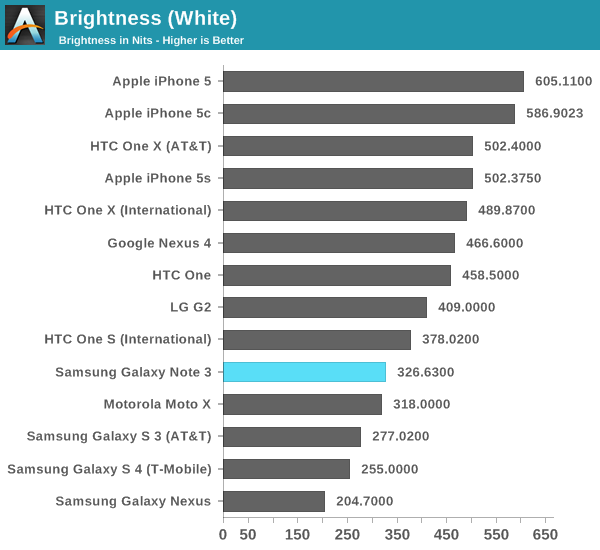
The Note 3 has the same display mode settings as we’ve seen in other generations, these mDNIe toggles allow some control over display color curves. They’re ultimately not a mitigation for Android’s lack of a real CMS and don’t completely solve the oversaturation issue that comes hand in hand with AMOLED’s different spectral curves, but they do help somewhat. These are unchanged as well from the SGS4 – Adapt Display is checked by default and will select which mode to use automatically for first party apps and a few others, but you can select between dynamic, standard, professional photo, and movie manually, which have different tunings for white point, gamut, and saturation. There’s also still the toggle for automatically adjusting screen tone depending on what’s being displayed.
Of the modes and configuration options available, I don’t doubt for a second that the most used one will be the defaults, however if you’re looking for the most sane from a color accuracy perspective it’s still Movie mode with the auto screen tone toggle unchecked. I gave Samsung the benefit of the doubt and ran all my measures in Movie mode as a result, but also took saturation measures of the other modes so you can see the difference in gamut and saturation with what you get under those.

The Standard and Dynamic modes have a ton of oversaturation, extending far beyond sRGB. In Dynamic mode we can also see some compression going on at the higher saturation levels, effectively blowing out those colors even more, with the second to last point almost on top of the last point. Pro Photo mode clamps down gamut and makes saturation a bit more linear, but has some odd other artifacts that show up. With the Movie selection made, the Note 3 display is considerably more controlled and linear, and makes a dramatic difference in how everything appears on the Note 3 during normal use. If you care about display really this is the only setting you should be using.
White point in movie mode is still bluer than I’d like at an average of just over 7100K, but in the all important Gretag Macbeth patch test, Delta-E is pretty low and puts it among iPhone 5, HTC One, and G2 territory. The results under movie mode from the Note 3 are actually nicely controlled. It still isn’t perfect, but there’s at least been an attempt made to give users that option if they don’t want garish colors that might look great on a store display but not so great if you care about matching photos you’ve taken to a display or print later, or web content between desktop and mobile.
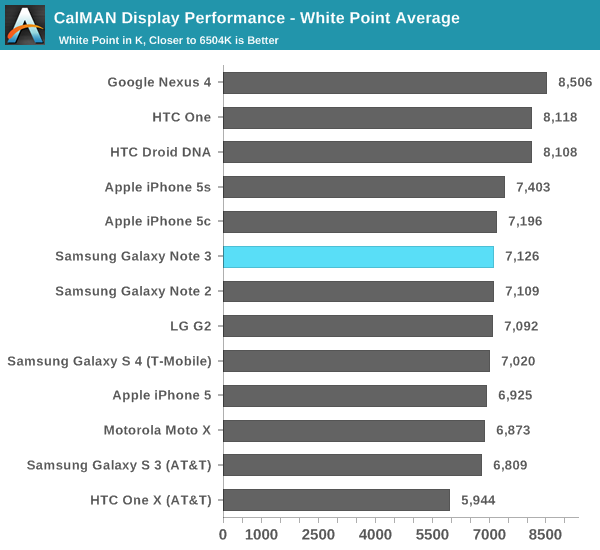
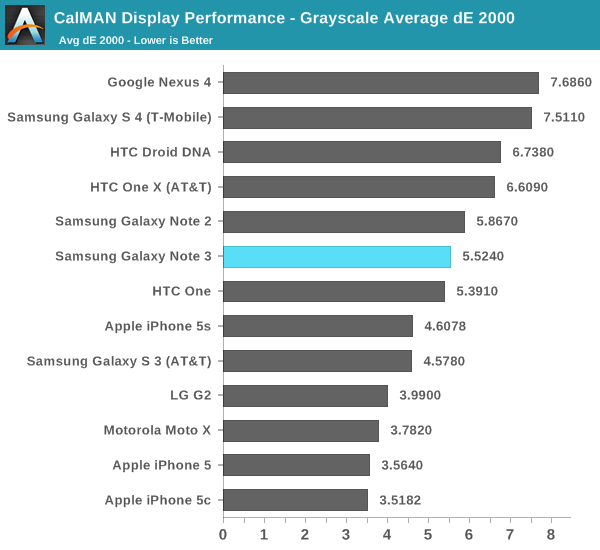
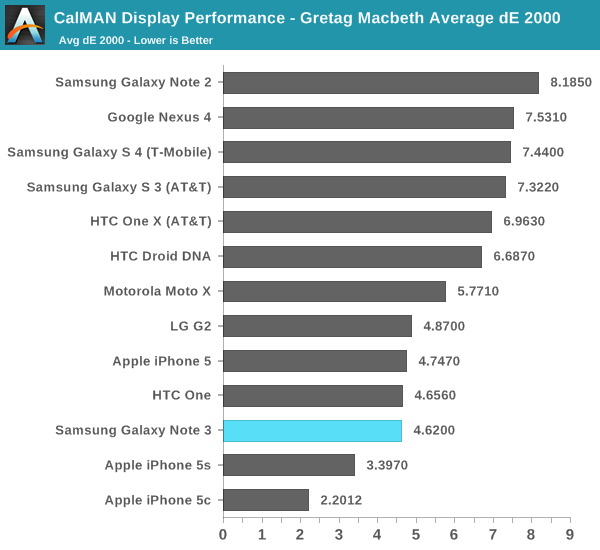
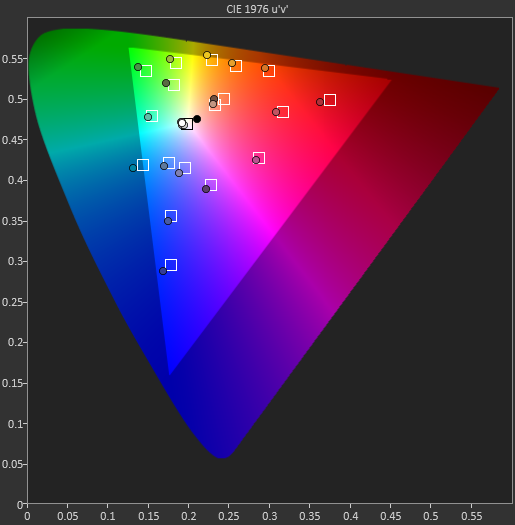
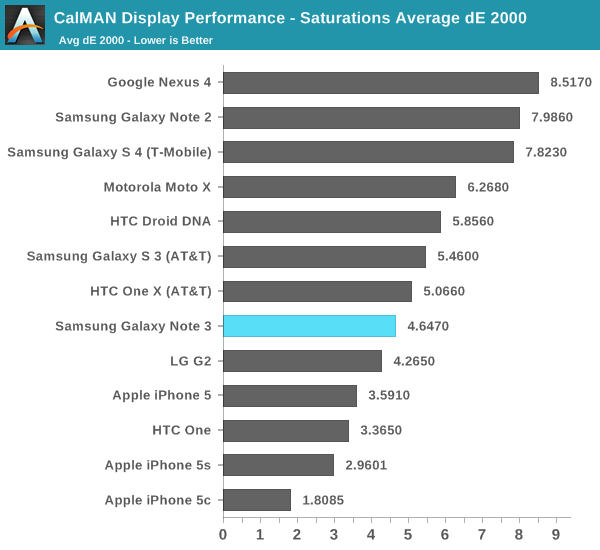



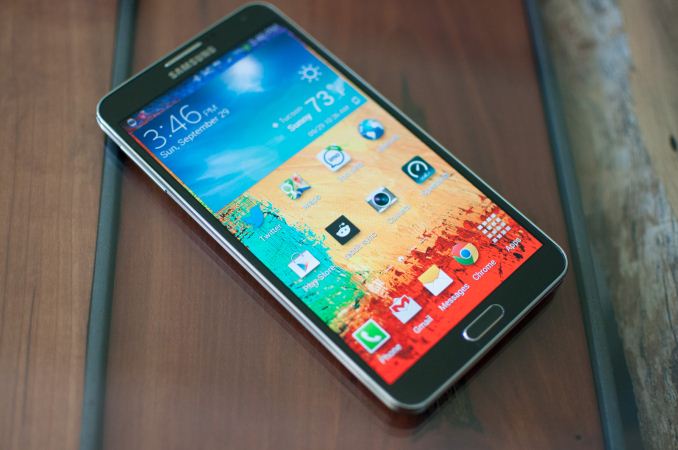
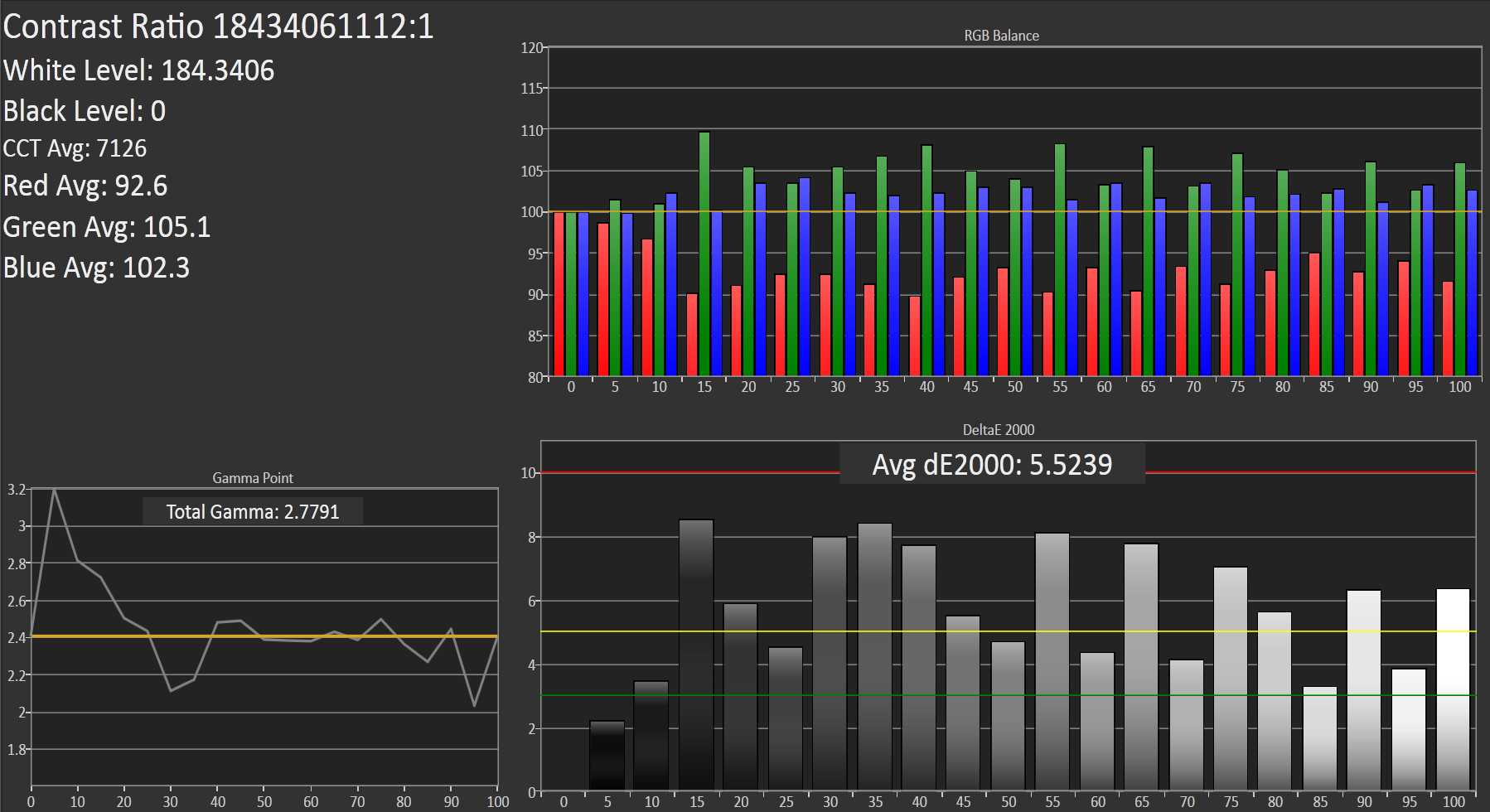








302 Comments
View All Comments
identity - Tuesday, October 1, 2013 - link
Anandtech said every Android device does it but keep ignoring that ok?Chillin1248 - Tuesday, October 1, 2013 - link
And because several (he never said all) manufacturers are cheating, the rest have to suffer?At the very least he could be fair and run the battery tests with the browser renamed as one of the "boost" apps. Let's see how Samsung (and others) will like how their results show up then compared to the manufacturers that aren't doing such blatant cheating.
identity - Tuesday, October 1, 2013 - link
Samsung still beat the G2 without the boost according to Arstechnica anyways. I doubt people will care if the HTC One uses the same boost(which it does and nobody cares) because it's not a threat to Apple and it's not Samsung,Chillin1248 - Tuesday, October 1, 2013 - link
But barely, not with the huge margin that we currently see in Anand's benchmarks.Anand, for the sake of your site's integrity; I plead with you to take down the current benchmarks and re-run them with ARSTechnica's workaround. Either that, or run the WiFi battery benchmarks while renaming the browser to one of the "boost" applications. That way, it will be a fair comparison of the Device's User Experience.
Squuiid - Tuesday, October 1, 2013 - link
Does that make it ok then? Benchmarks are used to compare cross platform devices. Pretty sure Apple and Microsoft don't inflate their benchmarks.Would you condone drug taking in sports if everyone doped?
stajcer - Tuesday, October 1, 2013 - link
I too am disappointed in Anandtech's coverage of this issue. I think that this is usually one of the best written and most in depth hardware review sites out there, but to (seemingly) gloss over this issue with one or two lines in the review and then state that the Note 3 has the fastest s800 chipset is just absolutely false. You know that its cheating, and you mention it in the review, but then coming to the conclusion that this is the 'fastest android device' based on benchmark info that you know to be misleading is a huge error IMO.Just because other companies do it does not excuse this behaviour. unless more people are made aware that they're cheating (one or two lines buried in the middle of a review dont matter) they'll keep doing it. The only way to end it is to blatantly call out the manufacturers that are doing it. Which means that you cant conclude something is 'the fastest' if you know that the benchmarks are run in a way on the device that it cant be replicated by the end user - end of story.
Klug4Pres - Wednesday, October 2, 2013 - link
I too am disappointed in the way Anandtech is choosing to deal with benchmark cheating. Either find a way to circumvent the cheating, or do not post benchmark results. It really is that simple.doobydoo - Saturday, October 19, 2013 - link
I completely agree. If you know a phone is boosting a benchmark - the point on the graph should be labelled as 'artificially boosted' or words to that effect. Then a non-boosted benchmark should be run.2disbetter - Tuesday, October 1, 2013 - link
I don't know... I'm not that bothered by Samsung's attempt to get higher scores. Their "cheating" as it were, is simply overclocking the chipset. The chipset IS in fact performing as the benchmark indicates. It's misleading, sure, but not really lying. We have long since surpassed the need for hardware speed improvements on any mobile OS, so bickering about performance seems kind of redundant. None of the premier phones today can actually really use their horsepower so ultimately what does it really matter?xype - Wednesday, October 2, 2013 - link
It matters because it makes the damn benchmarks useless. What help are performance graphs if they have to come with an asterisk and "Well, not that any performance difference seen herr matters anyway, cause we're too fucking lazy to put in the work and do a proper comparison."